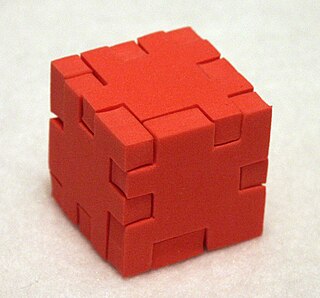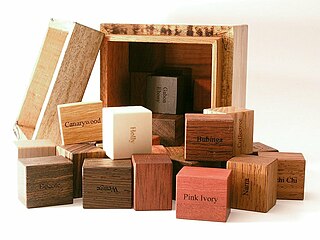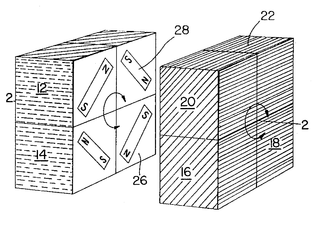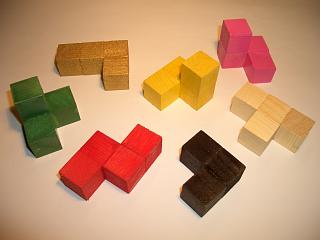 W
WThe Bedlam cube is a solid dissection puzzle invented by British puzzle expert Bruce Bedlam.
 W
WConway's puzzle, or blocks-in-a-box, is a packing problem using rectangular blocks, named after its inventor, mathematician John Conway. It calls for packing thirteen 1 × 2 × 4 blocks, one 2 × 2 × 2 block, one 1 × 2 × 2 block, and three 1 × 1 × 3 blocks into a 5 × 5 × 5 box.
 W
WThe diabolical cube is a three-dimensional dissection puzzle consisting of six polycubes that can be assembled together to form a single 3 × 3 × 3 cube. The six pieces are: one dicube, one tricube, one tetracube, one pentacube, one hexacube and one heptacube, that is, polycubes of 2, 3, 4, 5, 6 and 7 cubes.
 W
WThe Dino Cube is a cubic twisty puzzle in the style of the Rubik's Cube. It was invented in 1985 by Robert Webb, however it was not mass-produced until ten years later. It has a total of 12 external movable pieces to rearrange, compared to 20 movable pieces on the Rubik's Cube.
 W
WThe Gear Cube is a 3-D combination puzzle designed and created by Dutch puzzle maker Oskar van Deventer based on an idea by Bram Cohen. It was initially produced by Shapeways in 2009 and known as "Caution Cube" due to the likeliness of getting fingers stuck between the gears while speedcubing. Later, in 2010, it was mass-produced by Meffert's as the "Gear Cube".
 W
WHappy Cubes are a set of mechanical puzzles created in 1986 by the Belgian toy inventor Dirk Laureyssens. The company "Happy bvba" has the exclusive license to manufacture and sell these puzzles. Happy Cubes are also known by a number of other names, among them: "Cube It!" cubes, "Wirrel Warrel", "I.Q.ubes" and "Cococrash".
 W
WThe Helicopter Cube is a Rubik's Cube-like puzzle invented by Adam G. Cowan in 2005 and built in 2006. It is also in the shape of a cube. At first glance, the Helicopter Cube may seem like a combination of the 2x2x2 and the Skewb, but it actually cuts differently, and twists around cube edges rather than cube faces. The purpose of the puzzle is to scramble the colors, and then restore them back to their original state of a single color per face.
 W
WHoffman's packing puzzle is an assembly puzzle named after Dean G. Hoffman, who described it in 1978. The puzzle consists of 27 identical rectangular cuboids, each of whose edges have three different lengths. Its goal is to assemble them all to fit within a cube whose edge length is the sum of the three lengths.
 W
WLarry D. Nichols, born 1939 in the United States, is a puzzle designer. He grew up in Xenia, Ohio, and studied chemistry at DePauw University in Greencastle, Indiana, before moving to Massachusetts to attend Harvard Graduate School. He is best known for the invention of mechanical puzzles including 'The Nichols Cube Puzzle' (1974), patent US365520. He has lived with his wife Karen in Arlington, Massachusetts since 1959.
 W
WThe Nine-Colour Cube is a cubic twisty puzzle. It was invented in 2005 by Milan Vodicka and mass-produced by Meffert's seven years later. Mechanically, the puzzle is identical to the Rubik's Cube; however, unlike the Rubik's Cube, which only has 6 different colours, the Nine-Colour Cube has 9 colours, with the individual pieces having one colour each.
 W
WThe Rubik's Cube is a 3-D combination puzzle invented in 1974 by Hungarian sculptor and professor of architecture Ernő Rubik. Originally called the Magic Cube, the puzzle was licensed by Rubik to be sold by Ideal Toy Corp. in 1980 via businessman Tibor Laczi and Seven Towns founder Tom Kremer. Rubik's Cube won the 1980 German Game of the Year special award for Best Puzzle. As of January 2009, 350 million cubes had been sold worldwide, making it the world's top-selling puzzle game. It is widely considered to be the world's best-selling toy.
 W
WRubik's Domino is a hand-held puzzle similar to a Rubik's Cube. However, it has one layer removed, making it a 2×3×3 cuboid. The 3×3 faces can be turned 90-degrees as normal, but the 2×3 faces can only be turned 180 degrees. Other cuboids of 2×2×n will solve like multiple dominoes at once. When only using pairs of turns, the puzzle may be solved similarly to a 3x3. The original version had white and black plastic layers. Each 3×3 face displayed a number of dots from 1–9. More recent versions use the traditional six-colour scheme, as seen on most other twisty puzzles. It has 406,425,600 potential positions and any position can be made into a solved position in 19 moves. It was registered as US Patent number 4378116 on 29 March 1983 by Ernő Rubik.
 W
WThe Skewb is a combination puzzle and a mechanical puzzle in the style of Rubik's Cube. It was invented by Tony Durham and marketed by Uwe Mèffert. Although it is cubical in shape, it differs from Rubik's construction in that its axes of rotation pass through the corners of the cube rather than the centres of the faces. There are ten such axes, one for each space diagonal of the cube. As a result, it is a deep-cut puzzle in which each twist affects all three faces.
 W
WThe Slothouber–Graatsma puzzle is a packing problem that calls for packing six 1 × 2 × 2 blocks and three 1 × 1 × 1 blocks into a 3 × 3 × 3 box. The solution to this puzzle is unique. It was named after its inventors Jan Slothouber and William Graatsma.
 W
WThe snake cube is a mechanical puzzle, a chain of 27 or 64 cubelets, connected by an elastic band running through them. The cubelets can rotate freely. The aim of the puzzle is to arrange the chain in such a way that they will form a 3×3×3 or 4×4×4 cube.
 W
WThe Soma cube is a solid dissection puzzle invented by Piet Hein in 1933 during a lecture on quantum mechanics conducted by Werner Heisenberg. Its name is alleged to be derived from the fictitious drug soma consumed as a pastime by the establishment in Aldous Huxley's dystopic novel Brave New World.
 W
WThe Square-1, also known as Back to Square One and Cube 21, is a puzzle similar to the Rubik's Cube. Its distinguishing feature among the numerous Rubik's Cube variants is that it can change shape as it is twisted, due to the way it is cut, thus adding an extra level of challenge and difficulty. The Super Square One and Square Two puzzles have also been introduced. The Super Square One has two additional layers that can be scrambled and solved independently of the rest of the puzzle, and the Square Two has extra cuts made to the top and bottom layer, making the edge and corner wedges the same size.
 W
WThe Void Cube is a 3-D mechanical puzzle similar to a Rubik's Cube, with the notable difference being that the center pieces are missing, which causes the puzzle to resemble a level 1 Menger sponge. The core used on the Rubik's Cube is also absent, creating holes straight through the cube on all three axes. Due to the restricted volume of the puzzle it employs an entirely different structural mechanism from a regular Rubik's Cube, though the possible moves are the same. The Void Cube was invented by Katsuhiko Okamoto. Gentosha Education, in Japan, holds the license to manufacture Void Cubes.
 W
WThe Yoshimoto Cube is a polyhedral mechanical puzzle toy invented in 1971 by Naoki Yoshimoto , who discovered that two stellated rhombic dodecahedra could be pieced together into a cube when he was finding different ways he could split a cube equally in half. Yoshimoto first introduced his cube in 1972 at a solo exhibition entitled "From Cube to Space", and later developed three commercial versions. In 1982, Yoshimoto Cube No. 1 was included in the Museum of Modern Art's permanent collection.